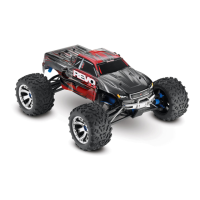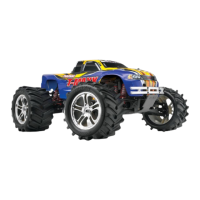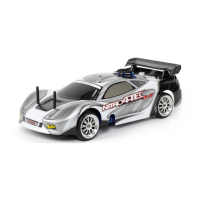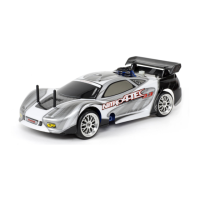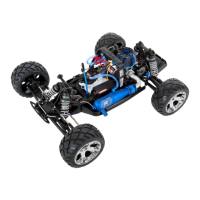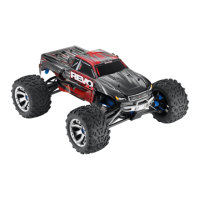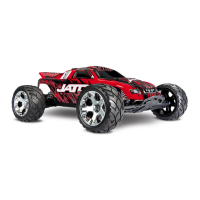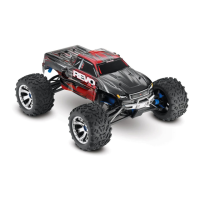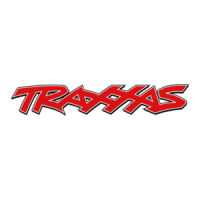
Do you have a question about the Traxxas T-Maxx 3.3 4908 and is the answer not in the manual?
| Engine Size | 3.3cc |
|---|---|
| Scale | 1/10 |
| Drive Type | 4WD |
| Fuel Tank Capacity | 125cc |
| Suspension | Independent |
| Radio System | 2.4GHz |
| Transmission | Automatic |
| Chassis | Aluminum |
| Shocks | Oil-filled |
| Engine | TRX 3.3 Racing Engine |
| Differential | Bevel Gear |
| Servos | Digital |
Information on how to contact Traxxas for assistance and support options.
A quick guide to get your model up and running efficiently.
Crucial steps to read and follow before operating your T-Maxx 3.3.
Explanation of icons used in the manual for warnings and hints.
Details on contacting Traxxas technical support and service.
Essential safety guidelines for operating the T-Maxx 3.3 safely.
Guidelines for safe handling and charging of rechargeable batteries.
Information on recycling Traxxas Power Cell NiMH batteries.
List of tools and equipment included with the T-Maxx 3.3.
List of tools and equipment necessary for operation and maintenance.
Optional equipment that is beneficial for R/C hobbyists.
Identification of major parts like Hex Hub, Skid Plate, and Bulkhead.
Details on suspension arms, steering servo, and related parts.
Identification of the TRX 3.3 Racing Engine, transmission, and fuel system.
Location of body mounts and wheelie bar components.
Steps for preparing the model, including radio setup and fluid filling.
Instructions for the critical engine break-in and initial tuning.
Guidance on applying tires to rims and attaching decals.
Definitions of key terms used in radio system operation.
Description and diagram of the TQ 2.4GHz transmitter controls.
Schematic showing the connection of receiver, servos, and battery.
Important safety guidelines for using the radio system.
Procedure for installing batteries in the receiver.
Procedure for installing batteries in the transmitter.
Information on the optional Traxxas TRX Power System.
Identification and function of transmitter controls like steering wheel and trigger.
How to adjust throttle neutral and steering trim.
Steps for turning on, checking, and operating the radio system.
Procedure for testing radio signal range before operation.
How to adjust steering sensitivity using the Multi-Function knob.
Instructions for binding the transmitter/receiver and setting up the antenna.
Overview of the TRX 3.3 Racing Engine's features and design.
Definitions of key terms related to the nitro engine.
Critical steps for the proper break-in of the new engine.
Procedures for maintaining the air filter and performing after-run.
Comprehensive list of terms and definitions for the engine.
Diagram identifying all major parts of the TRX 3.3 Racing Engine.
Guidelines on choosing the appropriate fuel for the engine.
Safety instructions for handling and storing model engine fuel.
Procedure for safely refilling the model's fuel tank.
Explanation of the fuel tank seal's role in engine performance.
Details on the two-stage air filter and its components.
Instructions for cleaning pre-filter and primary filter elements.
Explanation of carburetor's role and the concept of air/fuel mixture.
Description of high-speed and low-speed needles for tuning.
How to adjust fuel mixture using needle valves and idle speed screw.
Default settings for carburetor needles if tampered with.
Overview of the electric starting system and its components.
Instructions for charging the EZ-Start battery pack.
Steps for installing the battery into the EZ-Start controller.
Correct method for shutting down the engine.
Why proper break-in is critical for engine performance and longevity.
Steps for starting the engine for the very first time.
Key points and safety checks before and during break-in.
Detailed procedure for each of the first five tanks of fuel.
Special considerations for breaking in the engine in different climates.
Procedure for adjusting the high-speed needle for optimal performance.
Procedure for adjusting the low-speed needle using the pinch test.
How to set the engine's idle speed correctly.
Guide to adjusting fuel mixture based on weather conditions.
Tips for fine-tuning and using temperature for adjustments.
Safety rules and warnings for operating the T-Maxx 3.3.
Advice on handling the truck, cornering, jumping, and obstacle negotiation.
How shock mounting positions affect suspension and ride height.
Adjusting shock oil viscosity and pistons for optimal handling.
Adjusting pivot ball caps and caster angle for suspension tuning.
How to set static camber and adjust toe-in for proper alignment.
Procedure for adjusting the slipper clutch for drivetrain protection.
How to adjust the shift point for the two-speed transmission.
Changing clutch bell and spur gear for different performance characteristics.
Procedure for setting the correct gear mesh between spur and clutch bell gears.
Adjusting the brake pads and shoulder screws.
How to install and adjust the wheelie bar for desired performance.
Tasks to perform after each hour and each running session.
Regular checks for screws, parts, wiring, and fuel lines.
Essential steps to protect the engine from corrosion after use.
Troubleshooting steps for radio not working or short range.
Diagnosing why the engine won't spin or won't start.
Addressing sluggish performance or starting difficulties.
Procedure for clearing excess fuel from a flooded engine.
Steps to unstick a piston stuck at TDC.
How to reset the transmitter to its default factory settings.
Adjusting throttle sensitivity, steering percentage, and braking percentage.
Using failsafe and sub-trim for precise servo control.
Managing model memory, locking settings, and Traxxas Link.
Interpreting transmitter and receiver LED indicators for system status.
Guide to navigating the transmitter's menu tree for settings.
Quick reference for adjusting specific transmitter functions.
